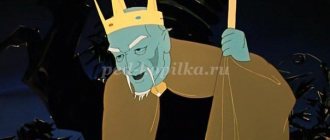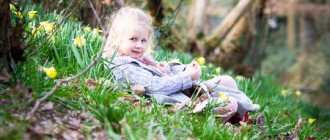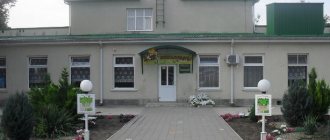Setting a goal for a spring walk
Each walk has its own purpose. In the first half of the day, it is important to restore strength after exercise and recharge with positive energy. On a morning walk, the child should unwind, relieve tension, and lift his spirits, which will provide fertile ground for successful physical, mental and mental development.
The senior group of kindergarten has two walks a day.
The purpose of the evening walk is established taking into account the previous activities of the pupils. In the evening you can plan outdoor games, physical exercises, and work activities.
Important! In the evening, it is not recommended to play games that greatly excite the nervous system of children.
The role of the teacher in the observation process
The teacher should pay special attention to planning observations during walks. An important role in the development of preschoolers is played by familiarization with real objects in the process of their direct use. Two observations are planned in the preparatory group of the kindergarten.
By observing, children become familiar with the world around them.
Observations are planned according to the weather and time of year. They can be both short-term and long-term. By observing, children develop aesthetics of perception, intelligence, interest in cognitive activity and studying the environment.
In child development, the following types of observations are used: of inanimate objects and living nature, of transport, of living objects, of the work of adults.
Note! When planning observations, it is necessary to follow instructions for protecting the life and health of children.
Organization of labor activities
Labor activity is based on the knowledge and skills that children already have. The subject of work activity can be different: domestic or industrial, to reinforce traffic rules, theatrical or construction.
Through work, children gain practical work skills
Most often, two types of work activities are organized during a walk:
- Household: children, together with the teacher, clean the area, play corners, cabinets;
- Work in nature: children work in the flower garden, flower bed, vegetable garden.
In addition to teaching children practical work skills, the teacher introduces them to plants, animals, the rules of caring for them, thinks through methods for organizing children, and the sequence of work.
We use outdoor games
Outdoor games, in which all children in the group take part, occupy an important place in the walk. The teacher gets the children interested in the game, captivating them.
Important! Only the child’s relaxed participation in the game creates a good mood, ensuring the educational effect of the game.
During a walk you can play from one to four outdoor games. When planning, you need to pay attention to the basic movements in the game. So, when it’s warm, it’s better to choose games in which you need to throw, crawl, and climb; when it’s cold, you need to run and jump.
The teacher not only participates in the game, but also takes on the main role. All children in the group must play, so during walks children are offered well-known games. Children are introduced to new games in physical education classes.
Children love outdoor games during walks.
Outdoor games teach children to be attentive, control their movements, and teach them discipline and a conscientious attitude.
How to develop fine motor skills in a child
When using outdoor games, the age and individual characteristics of children, educational goals and physiological patterns of adaptation to stress are taken into account. Before the game, the rules are clearly explained and roles are assigned.
Individual development
The correct organization of motor activity of preschool children affects the health-improving effect. When planning a walk, the teacher takes into account individual work with children on physical development. Individual work is planned with those children who have problems mastering basic activities.
Note! Each child has an individual degree of mobility.
Individual work can be organized in the form of a game or sports competition.
Card file of walks with goals for March for the preparatory group for the Federal State Educational Standard
Below are several themes for March walks with children in kindergarten.
Card “Observing Seasonal Changes”
Goals: developing the concept of seasonal natural phenomena (snow melts in spring, streams flow, birds fly in, trees turn green); consolidation of knowledge about the sun (the day becomes longer and the sun becomes warmer).
Progress of observation
The teacher talks about the signs of spring and asks the children questions:
- What happens to nature in spring? (The snow is melting, the wind is warmer, the leaves are turning green, the streams are flowing.)
- How do plants change? (Leaves or flowers bloom, grass turns green.)
- Which months are winter and which are spring? February is...
Labor activity: Cleaning up garbage on site. Goal: be proud of yourself for the work you have done.
Outdoor games: “Catch”, “Homeless Hare”. Goals: practice running without bumping into each other; develop agility and endurance.
Individual work: exercises to develop balance.
Willow Observation Card
Goal: to form an idea of willow in the spring, excursion to the botanical garden.
Progress of observation
Willow can be shown in the picture
The teacher takes the children on an excursion to a place where there is a willow tree. Talks about the tree and asks the children questions.
- What branches does the willow have? (Flexible, long.)
- What color are willow leaves? (Silver-green.)
- What is made from willow branches? (They weave furniture.)
- How was the willow in winter? What was it like in the spring?
Labor activity: cleaning old grass with a rake. Goal: to teach people to work together.
Outdoor games: “Gardeners”, “Burners”. Goal: run on command.
Individual work: jumping on one leg.
Hail Watch Card
Goals: introduce the city; give an idea of the origin of the hail.
Progress of observation: Rainwater evaporates under the rays of the sun and rises to the clouds, where it is very cold. There, the water vapor turns into small round pieces of ice. When pieces of ice fall, some of them have time to melt, and some do not. That's why hail always comes with rain.
Research activity: observe and find out where ice peas melt faster: on the road, under bushes, etc.
Labor activity: cleaning pruned branches of bushes and trees. Goal: to teach how to work in a team, to complete a task, and to evaluate the results of one’s work.
Environmental education of preschool children
Outdoor games: “Birds and fox”. Goal: to teach how to deftly jump from stump to stump, run without bumping into each other, and find your own stump on command.
Individual work: learn to run in a column, one at a time, at an average pace.
Dog Observation Card
Objectives: systematize ideas about animal life; searching for changes in the lives of animals; development of evidentiary speech; fostering a sense of responsibility for those who have been tamed.
Progress of observation: The teacher shows pictures of puppies and asks the children:
Picture 6 A dog is man's best friend.
- Who is this puppy: a boy or a girl?
- Let's choose a name for the puppy!
- What is the dog's mood?
- What do you think your puppy likes to do most?
A dog is a devoted friend. If she was taken into the house, it means she has owners. They must take care of her: feed and support her, and most importantly, love her.
Labor activity: Digging up soil for planting seeds. Goals: to strengthen the ability to work collectively; to form diligence, the desire to complete the work started.
Outdoor games: “Classics”. Goal: improve the ability to jump on one leg, navigate in a limited area; develop eye and accuracy.
Individual work: improve jumping technique (exercises with a long rope).
Cloud watching
Goal: to form the consciousness of the unity of earth and sky as the basis for a holistic perception of the world.
Progress of observation: During a walk, the teacher invites the children to look at the sky.
- What can you see in the sky?
- Describe the clouds today.
- Will it rain today?
- Where are the clouds going?
Labor activity: planting flower seeds for seedlings. Goal: teach to work together, enjoy the work done.
Outdoor game: “Bunny Bunny” Objectives: to exercise the ability to run without bumping into each other; develop agility and endurance.
Individual work: learning the tongue twister “There is grass in the yard, there is firewood on the grass.”
Watching the snow
Objectives: to pay attention to seasonal changes in nature; consolidate knowledge about the relationships between “sun and snow” (walk in the preparatory group in March).
Progress of observation: There are signs: if the snow flakes become large, wait for a thaw; the bullfinch sings in winter in the snow, blizzard and slush - wait for early spring.
Spring came
Research activity: measure the depth of snow in the sun and in the shade.
Labor activity: clearing paths from snow. Goal: learn to work together, improve the ability to work with a shovel.
Outdoor games: “Hares and wolves.” Goal: develop the ability to run quickly and dodge the catcher.
Individual work: hit the target with a snowball.



